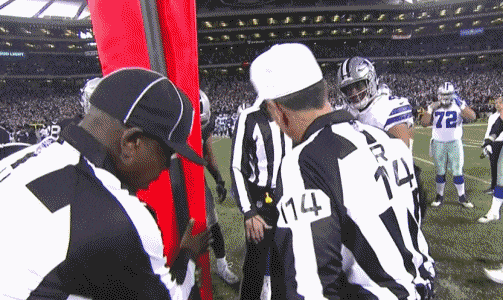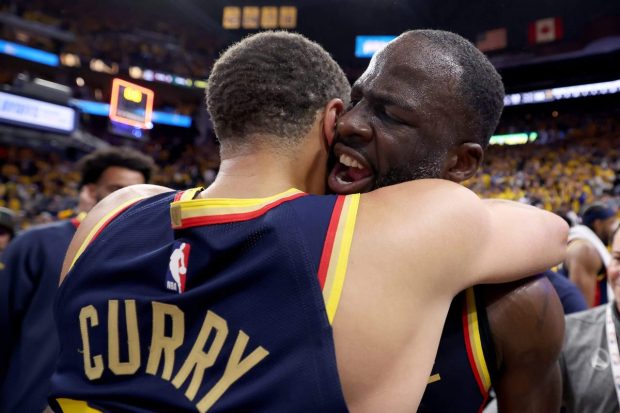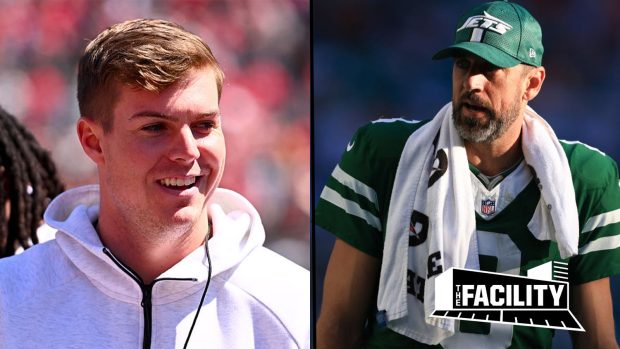
Inside: Pro day risers, a draft fact from Dane Brugler and why the Eagles can still run the tush push for now, plus new rule changes for 2025.
One thing we’ve lost: The index card first down. RIP.

Yesterday, the NFL announced Sony’s Hawk-Eye technology will “serve as an efficient alternative to the process of walking chains onto the field and manually measuring.” And I thought chain gangs had the world’s strongest union.
Later in the NFL’s email: “The chain crew will remain on the field in a secondary capacity.” Same group, less work? Teamsters have nothing on these guys.
Let’s talk rule changes.
This article is from Scoop City, The Athletic’s NFL newsletter. Sign up here to receive it directly in your inbox.
Three takeaways from league meetings
This past Sunday, the NFL’s power brokers began their series of annual meetings in Palm Beach, Fla. One of the most important moments on the league calendar each year, it’s when strategic decisions — like whether to keep discussing international expansion (always) or move to 18-game seasons (not yet) — are made.
Advertisement
It’s also when the league’s Competition Committee presents proposed rule changes to the 32 owners. To be adopted, a new rule or a revision must have the support of 75 percent of them (24 yes votes). Three key takeaways:
1. Tush push stays, for now. Yesterday, NFL owners decided to table the vote on the Packers’ proposal until May.
“Push” is the key word up for debate, as Green Bay wants the league “to prohibit an offensive player from pushing a teammate who was lined up directly behind the snapper and receives the snap.”
There’s a history of rules about assisting the ballcarrier. The early version of football’s current most controversial play was the violent flying wedge, mostly outlawed by college decision-makers in 1894. Various debates continued until 2006, when the NFL permitted pushing the ballcarrier, a penalty that had been rarely called (instead, officials often whistled the play dead).
As beat reporter Brooks Kubena explains, Philly capitalized on this better than anyone:
“The Eagles have run their quarterback 122 times in 1-yard-to-go situations since 2022. The Bills, Steelers (55) and Broncos (52) are the only teams who’ve surpassed 50 such runs.”
This emphasis took what was once a novelty and turned it into the most controversial play in football. Should it be? As Jason Lloyd writes, there is no data to support the detractors’ claim that the tush push leads to more injuries.
In February, Packers president Mark Murphy had another complaint: “There is no skill involved, and it is almost an automatic first down on plays of a yard or less,” he wrote, which Nick Sirianni and The Athletic’s Ted Nguyen vehemently disagree with. (Ted: “If no skill is involved, why are the Eagles better at executing it?”) With the owners declining to vote, the future of the play has been … pushed into the future. (I had to.)
2. New overtime, replay rules. As for the rules that did change, NFL owners agreed to the following:
- Playoff overtime rules in the regular season. This gives each team at least one possession, except for one extremely rare scenario: The first team to receive the ball scores at the end of a 10-minute drive. (The regular-season overtime period remains 10 minutes long, while playoffs are 15.)
- Expanded use of replay assist. On-site replay officials can now reverse flags for fouls involving tripping, roughing the kicker, face mask or horse-collar tackles and hits to defensive players. No flags can be added after the fact.
3. More kickoff returns, same format. The first year of the dynamic kickoff succeeded: 32.8 percent of kickoffs were returned, a 57 percent increase from the year prior, while more were returned for touchdowns (7) than in each of the prior four seasons.
It also helped on the injury front, with the NFL reporting that the change “led to a lower concussion rate (down 43 percent vs. 2021-2023 average) and the fewest lower-extremity strains on the play since at least 2018.”
Advertisement
There was one caveat: There were still too many touchbacks. Boring. In response, owners voted to move kickoff touchbacks to the 35-yard line (it was the 30 last year). At a press conference yesterday, Broncos special teams coach Darren Rizzi said he expects the return rate to skyrocket as high as 75 percent. I’ll always sign off on more action.
For more, The Athletic detailed every by-law and rule change you should know. Over to Dianna before we touch on some pre-draft risers.
What Dianna’s Hearing: Those Cousins-to-the-Browns rumors
During this week’s league meeting, the Falcons acknowledged that a Kirk Cousins trade is at least a possibility. “At the end of the day, what happens happens, maybe something pre-draft, draft, post-draft, I don’t know,” team owner Arthur Blank told reporters on Tuesday.
There are some obvious dots to be connected when it comes to Cousins potentially going to the Browns. The team needs a quarterback, and Kevin Stefanski spent two seasons as quarterbacks coach and offensive coordinator in Minnesota when Cousins was there. There’s a lot of smoke, and based on conversations I’ve had with various sources across the league, it wouldn’t be a surprise if Cousins is an option for Cleveland.
Back to you, Jacob.
Trending up after pro days
The value front offices place on pro days and in-person visits seems to grow in proportion to declining player participation at the NFL combine.
Pro days also offer draft expert Nick Baumgardner another chance to watch top prospects. Nick recently detailed notable results from the pro-day circuit, where two 40-yard dash times stood out:
Arizona WR Tetairoa McMillan clocked in at 4.55, fast given his 6-foot-4, 219-pound frame. That long speed combines with his short-area quickness and versatility to make McMillan — the No. 7 prospect on Dane Brugler’s Big Board — the first receiver expected to be drafted after Colorado CB/WR Travis Hunter. In mocks, the landing spots vary, but the Cowboys at No. 12 are a strong possibility.
Advertisement
Texas RB Jaydon Blue ran his 40 in an impressive 4.25 seconds, a substantial improvement from his combine number (4.38). Previously an afterthought due to his size (5-foot-9, 196 pounds), Blue could move him up into Day 2 of the draft. Multiple reports said the Broncos and Eagles are hosting Blue for a top-30 pre-draft visit.
Nick’s roundup of pro-day metrics has everything else you should know before we finally (probably) see Shedeur Sanders throw at Colorado’s on April 4 —though I haven’t seen confirmation he is throwing, his draft stock needs it.
Ready for The Beast?
Each April, The Athletic’s Dane Brugler publishes his comprehensive draft tome, aptly titled The Beast. It’s essential reading for all NFL fans, and it’s coming soon.
For now, Dane joins us to give an exclusive glimpse at the intel he has cooking. My question: Can you share one nugget you’ve learned about a receiver?
💬 Dane: Ole Miss WR Tre Harris was Malik Nabers’ quarterback in high school. Harris left the football team to focus on basketball, but it was Nabers who convinced him to come back and throw passes to him. Harris moved to receiver at Louisiana Tech before transferring to Ole Miss.
At 6-foot-3, 210-pounds, Harris has the build of a passer. But he’s clearly found his niche: Dane lists him as the No. 68 player on his Big Board, writing that Harris “can be a productive Robin for an NFL offense that already has a go-to target.”
Asking the NFL
Did the Bengals get it right? That’s one of the many AFC questions Mike Sando asked NFL executives in his latest survey.
“The thought of keeping their quarterback happy is good,” one exec said, “but how can you build around him to get him where he needs to go? I’m going to go with fronts and defense over skill, especially when you already have one of the highest-paid receivers. To sign another one (Higgins) is interesting to me.”
The Patriots took a different approach, spending heavily to reinforce their defense. Mike explains why New England still has plenty of work ahead, plus asks if the Browns might tank for Arch Manning. The full article is worth your time.
Monday’s most-clicked: The annual photo of (almost) all 32 NFL head coaches.
📫 Enjoyed this read? Sign up here to receive The Athletic’s free daily NFL newsletter in your inbox.
Also, check out our other newsletters.
(Photo: Patrick McDermott / Getty Images)
This news was originally published on this post .










Be the first to leave a comment